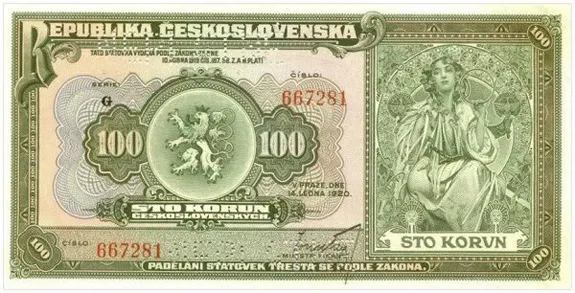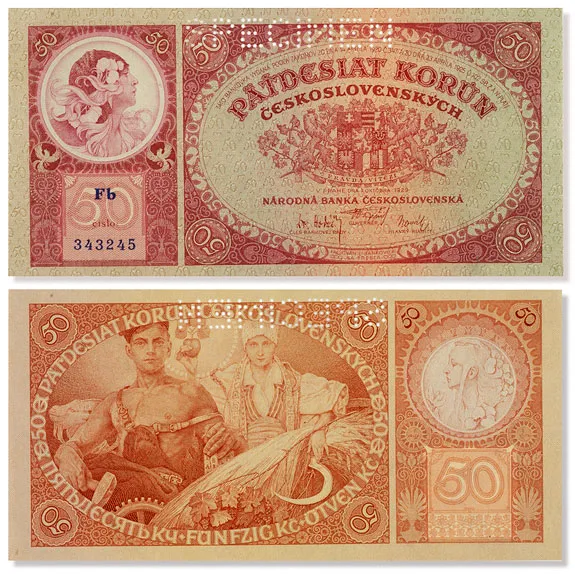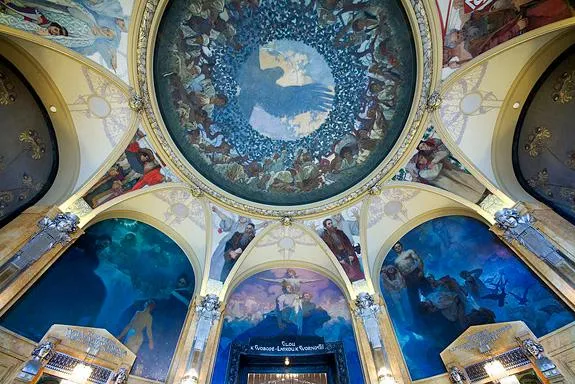How Alphonse Mucha Designed the Nation State of Czechoslovakia
When the country gained its independence after World War I, Alphonse Mucha was called upon to design an important part of any country’s identity - money
/https://tf-cmsv2-smithsonianmag-media.s3.amazonaws.com/filer/7b/51/7b513869-6e7f-46a4-9ec0-b1bc671e24a1/alphonse-mucha.jpg)
In the aftermath World War I, artist and designer Alphonse Mucha helped define the image of the newly independent country of Czechoslovakia. Born in Moravia (now part of the Czech Republic), Mucha was a devoted Czech patriot and developed a unique artistic style that he firmly believed embodied the larger tradition of his his country and he encouraged his peers to define and strengthen a true Czech style. It’s appropriate then, that he was the man who the country turned to as they constructed their national identity.

On October 28, 1918, the Republic of Czechoslovakia was born and Mucha, patriot that he was, was determined to do everything he could to help the development of his new nation. When the government asked him for help designing documents, he immediately agreed. Mucha’s first project for his country was Czechoslovakia’s first postage stamps. Mucha completed the design in 24 hours: a panorama of the eclectic Hradčany Castle (also known as the Prague Castle), surrounded by the natural lacework for which the artist had become so well known. Mucha explains why he selected Prague Castle:
“Every nation has a palladium of its own embodying past and future history. Ever since my boyhood I felt and saw in the architectural lines of St. Vitus Cathedral built so close to the castle, a powerful interpretation of our national symbol. I could, therefore, select no other subject for my design than Hradčany Castle and the surrounding architecture of the Middle Ages.”
With over a billion printed between 1918 and 1992, when the union dissolved into two countries (Czech Republic and Slovakia), the Mucha stamp is by far the artist’s most widely reproduced work of art, a work for which the artist made no money, asking for only enough to cover his expenses.

In 1919 Mucha started making money for his country. Literally. He designed their money. While it may be true that money can’t buy happiness, Mucha’s son Jiří recalled the joy that his father felt at the opportunity to “talk in my own way to the spirit of the nation, to its eyes which carry thoughts most quickly to the consciousness.” All of this work was done free of charge in order to support the nascent nation. His 100 korun denomination, which entered circulation in 1919, was followed by six additional notes that would enter circulation over the next 10 years. So urgently did the country needs its banknotes, that Mucha did not have the luxury of fretting over the design and reused a portrait of Josephine Crane Bradley for the image of Slavia, the symbolic representation of a unified Slavic state.

Mucha’s work for Czechoslovakia wasn’t limited to the country’s stamps and banknotes. He also designed a new coat-of-arms, in use until 1961, as well as the various governmental documents and forms needed by any good bureaucracy. His work wasn’t limited to paper goods though: Alphonse Mucha also designed new police uniforms for the newly independent state.
Even before World War I, Mucha had contributed to the image of the Czech people when he was commissioned in 1910 to design the ornament for Lord Mayor’s Hall in the Obecní Dům (Municipal House), a newly created public building for civic events designed by architects Antonín Balšánek and Osvald Polívka. Mucha’s murals were created to celebrate the heroic history of the Czech people while expressing a strong belief in the nation’s unified future.

When Mucha was asked by the government to help create their identity, which would be distributed across Europe on envelopes and in currency, he was perhaps the most famous artist in the country. He was celebrated for his distinctive style of flowing natural forms, and his depictions of serene women in diaphanous robes surrounded by abstracted halo of flowers giving them an almost mythical quality. Mucha enshrines these women in a delicate, oraganic framework that sometimes made from the spiraling forms of their own hair, which curls and spirals into abstractions inspired by natural forms.
Though he believed his art was rooted in local tradition, the rest of the world often associated him with the Art Nouveau movement. Indeed, it could be said that Mucha accidentally pioneered the style when in 1895, by complete chance, he got the opportunity to design a poster for a production of Gismonda, starring Sarah Bernhardt. The poster was an immediate hit — so popular in Paris that the posters were being stolen off the streets by the enchanted public – and it began a long and fruitful collaboration between Bernhardt and Mucha. Mucha’s rise to prominence continued through his posters and other commercial graphics, and ultimately became a household name when a printing company started reproducing his illustrations for calendars, posters, postcards, and other publications. His posters are still popular today, just as common in college dorm rooms as they were on the streets of Paris and Prague.
For Mucha, it’s likely that this commercial work was just as important as the government work. Mucha believed in the transformative power of art, the idea that art should be made for the people and should contribute to their spiritual and cultural evolution. The more ways he could reach the citizens of Czechoslovakia, the better. So it makes sense that he would want his illustrations to be reproduced on something as common as a matchbox. The stamps and the banknotes, then, are the ultimate evolution of his populist, national art form.
Unfortunately, Mucha’s story has a sad end. His fierce and outspoken nationalism made him an early target of the Gestapo when the Nazis occupied Czechoslovakia. Though he was released after days of interrogation, Mucha’s health deteriorated rapidly during his imprisonment, eventually leading to his death from pneumonia in 1939, while the country he so loved was once again under the control of outside forces.
/https://tf-cmsv2-smithsonianmag-media.s3.amazonaws.com/accounts/headshot/Jimmy-Stamp-240.jpg)
/https://tf-cmsv2-smithsonianmag-media.s3.amazonaws.com/accounts/headshot/Jimmy-Stamp-240.jpg)